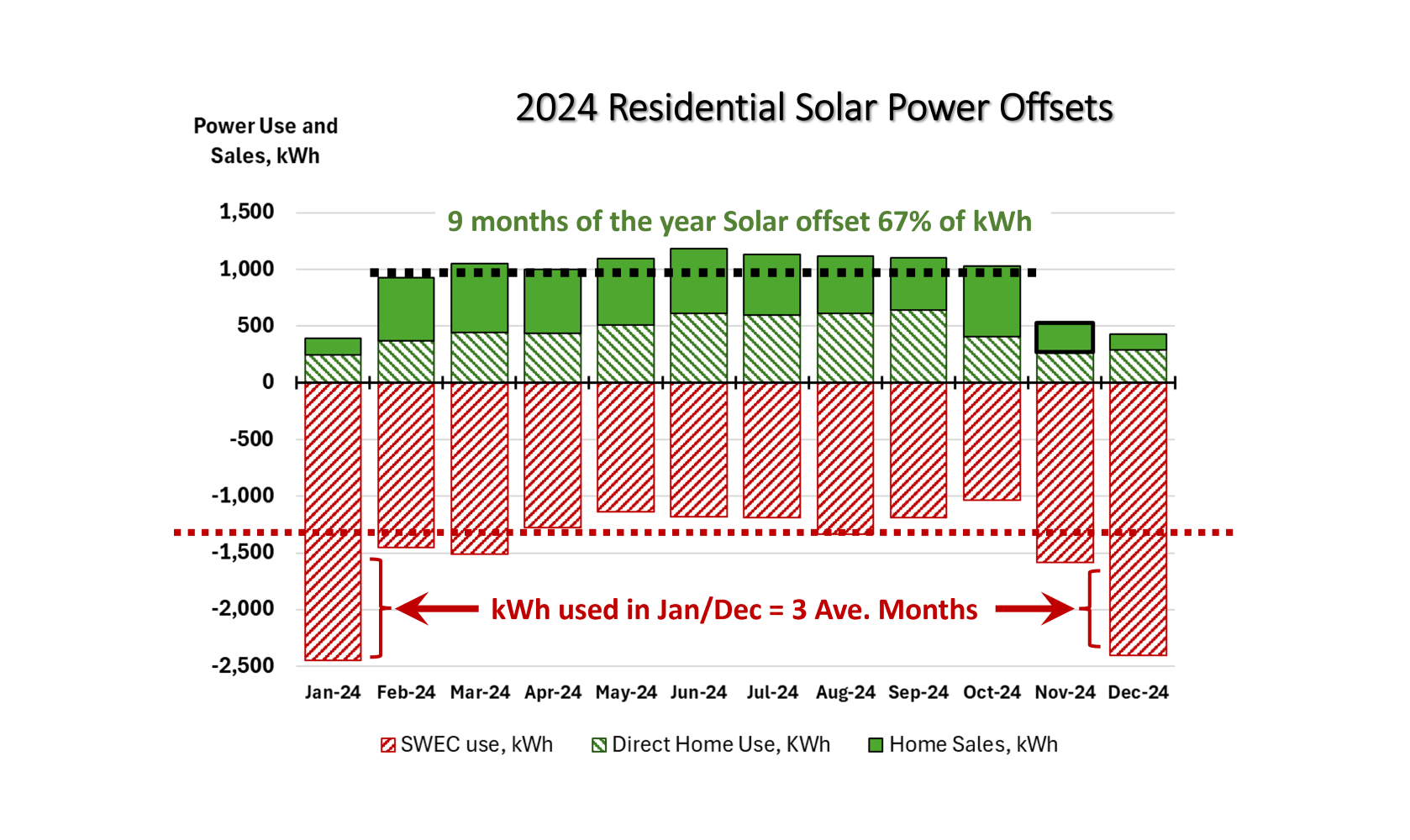Home Solar Array Offsets Two-Thirds of 2024 Power Consumption-Making $ense of Energy
After all is said and done, this residential solar array in the non-winter months offset 67 percent of home power production. This chart is monthly solar production and household consumption in kilowatt hours (kWh). While it required both the solar array production data and the electric cooperative solar power purchases and consumption data to compute, monthly calculations were straight-forward. Accounting for the benefits is a bit more challenging. But the deep dive in analytics in the last few weeks has been to gain a better understanding of power flows at the hourly data level.
This chart has direct use offsets listed as positive values. Direct use offsets are both production and consumption. The additive utility purchased power and direct consumption represents total household consumption. But the direct consumption of solar power has a one-to-one price offset that was not paid to the utility. In this chart, direct power data went directly from the solar array to household power use and is displayed as a benefit rather than a consumption cost.
The power sales data here is in kWh. The utility power purchasing agreement prices purchased solar power at one third of the price of what gets charged by the utility. So, the dollar value benefit from solar power sales is only 1/3 of the kWh benefit. In selling renewable energy purchase agreement terms are based on the policies of the regulated utility.
The power use history on the property for the year prior to solar panel installation reflected power use without residents. Construction was still occurring, and monthly power use was about 75 percent of monthly power use after it became the principal residence. So, the array was undersized based on historical power use.
Because of the dollar benefit difference between direct use and solar sales, it makes sense to expand our array only to the level of maximizing direct use. To make this calculation, it was helpful to look at hourly changes in production and consumption.
- On sunny days, it would help to have a slightly larger array to take any marginal offset opportunities off the table. It would extend offset power production and consumption earlier in the morning and later in the evening.
- On cloudy days, it would increase gross solar output. On cloudy days, all solar power would go into direct use. A larger array would increase cloudy day offset benefits. A larger capacity would be a hedge against cloudy days.
- Understanding the dynamics of morning and evening production, as well as the impact of cloudy days was not possible while only looking at the monthly data values.
In January and December 2024, there was a double whammy from low solar output and high power use. In those two months, the additional kWh of power consumed was equivalent to three additional average month power use in the other ten months. Our geothermal HVAC system seems to do better cooling in the summer than heating in the winter. If the residence could be sealed better against energy loss, or a supplemental efficient wood heating system could be added, it would change the annual energy consumption.
This home power audit has been very illuminating.
We have been evaluating home energy systems for more than 40 years. Regarding residential power on this property, we are just getting started. From a power generation standpoint, wind and hydro are next on the list. Think small and supplemental. No giant windmills or dams. The value offset in our area is the money maker, not power sales. Small scale wind and hydro systems operate in both daylight and non-daylight hours. Rainfall runoff may not be the same time as windy days or vice versa.
The good news is that the economics are complicated. But I have been studying this most of my career. Stay tuned for more home-power production and consumption adventures!



Comments
Home Solar Array Offsets Two-Thirds of 2024 Power Consumption-Making $ense of Energy — No Comments
HTML tags allowed in your comment: <a href="" title=""> <abbr title=""> <acronym title=""> <b> <blockquote cite=""> <cite> <code> <del datetime=""> <em> <i> <q cite=""> <s> <strike> <strong>